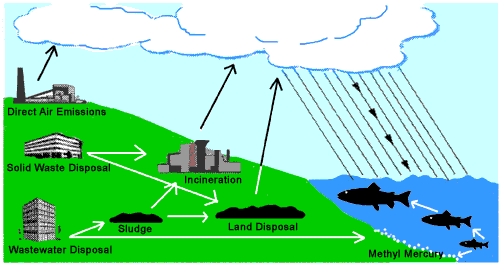Water Pollution (5/7)
Mercury & Heavy Metals

Mercury is a potent neurotoxin that is especially harmful to developing fetuses. It can cause sensory loss, tremors, loss of muscular coordination, speech, hearing, and visual problems, as well as increased risk of heart attack. Mercury occurs naturally in the environment, and can also be released into the air through industrial pollution. Mercury falls from the air and can get into surface water, accumulating in streams and seas. Bacteria in the water cause chemical changes that transform mercury into methylmercury that can be toxic. Fish absorb methylmercury from water as they feed on aquatic organisms.
Nearly all fish contain trace amounts of methylmercury, which are not harmful to humans. However, long-lived, larger fish that feed on other fish accumulate higher levels of methylmercury and pose a greater risk to people who eat them regularly. While it is true that the primary danger from methylmercury in fish is to the developing nervous system of the unborn child, it is prudent for nursing mothers and young children not to eat these fish as well. You can protect your unborn child by not eating these large fish that can contain high levels of methylmercury:
- Shark
- Swordfish
- King Mackerel
- Tilefish
Eat More Fish !
By WILLIE SOON and ROBERT FERGUSON
August 15, 2005
Perhaps the most repeated refrain driving the mercury alarmism campaign is that "630,000 American babies are born each year" with elevated concentrations of mercury in their blood, with the potential for "permanent brain damage and learning disabilities." these infants are said to be "poisoned" at birth because their mothers consumed fish containing micro traces of mercury. As a result, pregnant women are being terrified away from fish consumption, and thus denied a source of nutrition shown to enhance both fetal brain development and maternal health.
The genesis of this myth was the 2003 Centers for Disease Control release of its results from the 1999-2000 nutrition and health survey. It was reported that 8% of women of childbearing age (16-49 years old) had blood mercury concentrations above the so-called "safe" mercury reference dose established by the Environmental Protection Agency (EPA). Since there are over four million births in the U.S. annually, mercury opponents and several government scientists extrapolated that at least 320,000 babies born are "at-risk" in the U.S. each year due to "unsafe" mercury levels in their mother's blood.
In January 2004, an EPA employee revised the number of babies born at risk upward to 630,000, based on "new" information that mercury in maternal cord blood (shared with the fetus) is more concentrated than in body blood. But the information was not "new, " it was a double-counting, since the EPA had already accounted for the blood-concentration difference in 2001, helping make its "safe" mercury dose the most stringent in the world.
It must be recognized that the EPA's safe mercury dose is based on inappropriate studies of people who consume whale meat and blubber (a unique diet very different from typical U.S. consumption) containing multiple chemicals -- PCBs, cadmium, pesticides, persistent organic pollutants, DDT, etc. -- of which mercury is only one.
There are other reasons why mercury alarmists' emotive claims are neither justified nor credible. For example, a recent survey in Japan reported that 87% of the population, including 74% of Japanese women of child-bearing age, had mercury concentrations above EPA's "safe" level. Logically, one must either conclude that generations of Japanese are "brain-damaged" (and suffering from severe and permanent learning deficits), or that EPA's "safe" mercury dose is simply arbitrary and extreme.
Similarly, children in grades four and eight from traditionally high-fish-consumption cultures in Japan, Korea, Singapore, and Hong Kong consistently outperformed U.S. students on international standardized math and science tests. This, despite the fact that Hong Kong children have mean blood mercury levels some 10 times higher than U.S. children. Even the mummified remains of four Aleutian infants dated to 1445 A.D. contained higher mean mercury levels than young children reported in the CDC surveys.
None of these findings are surprising, considering numerous studies report no adverse effects on children from maternal fish consumption -- as high as 12-14 meals per week -- of the kinds of fish widely available in U.S. markets and restaurants. Only benefits have been reported, such as superior eyesight, higher child mental development scores, less hyperactivity, good heart and brain function, and improved intelligence at four years of age.
Finally, an examination of the actual CDC data shows that the 1999-2000 survey documented seven out of 705 children (or 1%) with blood mercury above the EPA's "safe" mercury dose, while the 2001-2002 survey found only four out of 872 children (or 0.5%) exceeding it. More importantly, even the highest mercury level measured in this four-year survey has a safety cushion of more than 500% of the lowest exposure level of concern.
Yet hardly anyone is rushing to report these important updates, let alone downward revisions in the numbers of children "at risk." Instead, one observes repetition of the near-religious dogma that "600,000-plus American children are born each year" at risk of "birth defects, including mental retardation and problems with motor skills." Basing enormously consequential energy and health policies -- both nationally and internationally -- on myth is both irresponsible and harmful.
Mr. Soon is chief science researcher, and Mr. Ferguson executive director, of the Center for Science and Public Policy.
